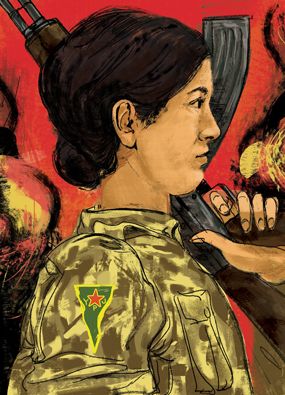
The faces of armed combatants are not always bearded.
In war zones around the world, women are serving in more varied roles—including on the front lines. Their contributions are often ignored, an oversight School of International Service professor Jessica Trisko Darden hopes her new book, Insurgent Women: Female Combatants in Civil Wars, will change.
“Women are just as important to, and just as involved in, matters of the state like war as men are,” she says.
The genesis for the project was a 2015 Washington Post piece she wrote with Ora Szekely of Clark University entitled “Warfare Isn’t Just a Man’s Game Anymore.” Szekely, along with Alexis Henshaw of Troy University, contributed to Insurgent Women.
Women have been participating in warfare in one form or another for centuries. Shortly after embarking on her research, Trisko Darden realized that she needed to narrow her focus.
“It made sense to look at civil wars, in which you’re battling over the future of your society,” she says. “Those are the sorts of conflicts where it’s not a political question of should we intervene in country X or not, it’s what’s happening in your own backyard. It’s a context in which women’s stakes are especially high.”
Trisko Darden examined the conflict in Ukraine, partly because some of her family originally hailed from the eastern part of the country. She used traditional and social media, including Russia’s version of Facebook, to conduct research on topics such as the military training women undergo.
Determining how many women participate in conflicts is difficult for myriad reasons. There are no official numbers for non-state armed groups, although it is estimated that between 30 and 40 percent of the fighting forces of the Revolutionary Armed Forces of Colombia (FARC) and the Kurdistan Workers’ Party (PKK) are female. (Those are the two other ongoing conflicts examined in the book.)
“Women’s roles are really fluid,” Trisko Darden says. “They often fulfill support roles, moving into combat roles if and when that’s necessary. But female casualties only make up about 16 percent of the PKK’s recorded casualties, so it’s really hard to say whether they’re keeping women away from the front lines or whether those are overestimations.”
Historically, women have been key members of intelligence operations for insurgencies, in large part because they are more tapped into social networks, Trisko Darden says. But some forces, like the FARC and the PKK, deploy mixed-gender combat units. Other organizations use women to advance an ideological stance. Terrorist organizations, for example, often recruit female suicide bombers. In some instances, groups “resort” to mobilization of women in order to shame men into joining.
One of the book’s most remarkable findings, Trisko Darden says, is that women participate in non-state armed groups even when those groups harm women.
“ISIS is a really good example,” she says. “It offers this sense of perverse empowerment. You can come join our group, and by living this really traditional, gender-stereotyped role you can be the true woman you were meant to be.”
A society’s inability to recognize women’s participation in conflict has dire consequences after the fighting ends.
“If you have a post-conflict reintegration program that offers women sewing lessons or [instructs them on] how to run a catering company, that’s not taking them seriously,” Trisko Darden says. “It’s devaluing their roles and not creating appropriate avenues for them to reintegrate into society.”
Too often the world thinks of women as either victims or peacemakers. Insurgent Women makes it clear that sometimes they are neither.